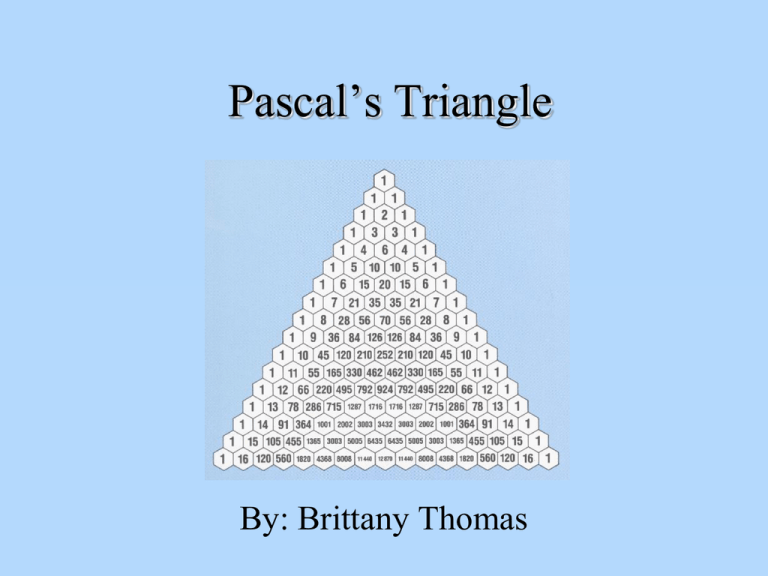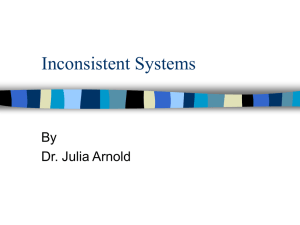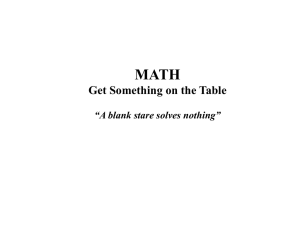Math Presentation
advertisement

Pascal’s Triangle By: Brittany Thomas History & Structure Pascal's Triangle was originally developed by the ancient Chinese, but Blaise Pascal was the first person to discover the importance of all of the patterns it contained. The tip of the triangle is always a one, as well as all the numbers on the outermost diagonals. To get the other numbers, you take any two consecutive numbers and add them. They create the number in between them in the next row down. The tip of the triangle is considered the 0th element, the second row is the 1st element, and so on. Sierpinski’s Triangle The pattern Sierpinski’s Triangle is formed when you clearly distinguish the odd numbers from the evens. For example, in this picture, the odd numbers were colored black and the even numbers remained white. The pattern creates more and more smaller triangles as you color more numbers. The sum of the rows The sum of the rows aren’t just any random numbers. They also form a pattern. The sum of a row is equal to 2n when “n” equals the number of the row. As you can see from the diagram, 2 to the 0th power equals 1. The 0 represents that it was the 0th row and in that row there is only a one; 20 equals one . 20 = 1 21 = 1+1 = 2 22 = 1+2+1 = 4 23 = 1+3+3+1 = 8 24 = 1+4+6+4+1 = 16 Square numbers A certain type of numbers in this triangle are square numbers. Square numbers are located in the third diagonal. A Square number is the sum of any two consecutive numbers in the third row of the triangle. Notice when all the circled numbers in the picture are added together, they make a square number. For example, 1+3=4 and 6+10=16. 4 and 16 are both perfect squares. Hockey Stick Pattern If a diagonal of numbers of any length is selected starting at any of the 1's bordering the sides of the triangle and ending on any number inside the triangle on that diagonal, the sum of the numbers inside the selection is equal to the number below the last number of the selection that is not on the same diagonal itself. 1+6+21+56 = 84 1+7+28+84+210+462+924 = 1716 1+12 = 13 Magic 11’s Another pattern discovered within the triangle is the Magic 11’s. The idea behind this pattern is that you need to take each row and convert it into a single number. The number is equal to 11 to the nth power or 11n when n is the number of the row the multi-digit number was taken from. For example, the third row (113) consists of a 1,3,3, and a 1; 113 equals 1331. Row 1 Row 2 Row 3 Row 4 Row 5 Row 6 Row 7 Row 8 Formul a 110 111 112 113 114 115 116 117 118 = = = = = = = = = = Multi-Digit number 1 11 121 1331 14641 161051 1771561 19487171 214358881 Actual Row 1 11 121 1331 14641 1 5 10 10 5 1 1 6 15 20 15 6 1 1 7 21 35 35 21 7 1 1 8 28 56 70 56 28 8 1








